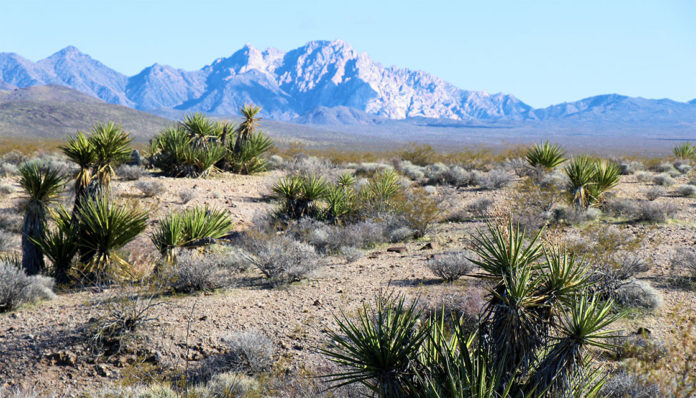WASHINGTON, D.C. – Secretary of the Interior Deb Haaland applauded President Biden’s designation of Avi Kwa Ame National Monument in southern Nevada. Located at the confluence of the Mojave and Sonoran Deserts, the national monument will protect innumerable objects of historic and scientific interest, including its namesake Avi Kwa Ame – or Spirit Mountain – and the surrounding arid valleys and mountain ranges that are historically important and sacred places for several tribal nations.
The action builds upon decades of efforts from the Fort Mojave Indian Tribe and other tribal nations to honor their creation story and to protect the integrity of the historic, cultural and physical landscape they hold sacred. Designation of the Avi Kwa Ame National Monument enjoys support from local, state and tribal governments in Nevada, Arizona and California, as well as a broad coalition of local businesses, outdoor recreationists, and conservation organizations.
“Avi Kwa Ame holds deep spiritual, sacred and historic significance to the Native people who have lived on these lands for generations,” said Secretary Haaland. “I am grateful to President Biden for taking this important step in recognition of the decades of advocacy from tribes and the scientific community, who are eager to protect the objects within its boundaries. Together with tribal leaders, outdoor enthusiasts, local elected officials, and other stakeholders, we will manage this new monument for the benefit of current and future generations.”
The new Avi Kwa Ame National Monument consists of approximately 500,000 acres of federal lands within Clark County. The monument will be co-managed by the Bureau of Land Management (BLM), as part of its National Conservation Lands System, and the National Park Service, as part of the Lake Mead National Recreation Area.
The national monument’s desert mountains and valleys are marked by the history of more than 10,000 years of human inhabitants – from ancient petroglyphs, rockshelters, and artifacts, to more recent evidence of trade routes, historic mining, and military training during World War II. Mojave desert tortoise, Gila monster, desert bighorn sheep, and centuries-old Joshua trees are among the species that can be found on this diverse desert landscape.
The designation will facilitate a wide range of opportunities to recreate in the national monument, including hiking, hunting, motorized recreation, and camping. In 2021, Nevada’s growing outdoor recreation economy contributed nearly $5 billion to the state’s economy and supported more than 50,000 jobs.
To ensure that management decisions are informed by Indigenous knowledge and tribal expertise, the presidential proclamation calls for co-stewardship of the national monument with interested tribes that have historical and spiritual connections to the monument lands. In addition, the proclamation calls for the BLM to establish a monument advisory committee that includes representatives from tribal nations, local governments and businesses, recreational users, hunting organizations, and local citizens.
Secretary Haaland visited the Avi Kwa Ame area in September 2022, where she met with tribal leaders and hosted a roundtable with the local community to discuss the need to conserve the ecological, cultural, historical and natural integrity of the landscape for present and future generations. In November 2022, Principal Deputy Assistant Secretary for Land and Minerals Management Laura Daniel-Davis and BLM Director Tracy Stone-Manning held a public meeting in Laughlin, NV to hear from the community about the proposal to designate existing public lands as a national monument. The Interior Department also provided opportunities for federally recognized tribes with historic or cultural ties to Avi Kwa Ame to provide input on the monument proposal.
The designation does not affect valid existing rights, nor does it preclude the construction and maintenance of utility, pipeline and telecommunications facilities, roads or highway corridors, or water infrastructure, including wildlife water developments and water district facilities, that occur consistent with proper care and management of monument objects.
The State of Nevada continues to play a leading role in the clean energy transition, helping the nation meet its goal of permitting 25 gigawatts (GW) of renewable energy by 2025. Outside of the national monument boundaries, the BLM has identified more than nine million acres of public lands within the State of Nevada that may be appropriate for solar development. Additionally, BLM is currently reviewing more than three dozen proposed renewable energy projects in the state that would add more than 13 GW of potential clean energy generation to the grid if constructed.
President Biden designed the national monument using his authority under the Antiquities Act. The Antiquities Act was first used by President Theodore Roosevelt in 1906 to designate Devils Tower National Monument in Wyoming. Since then, 18 presidents from both parties including recent Presidents Trump, Obama, G.W. Bush and Clinton, have used this authority to protect unique natural and historic features on federal lands in America, such as the Grand Canyon, the Statue of Liberty, and the Basin and Range National Monument in Nevada.













































